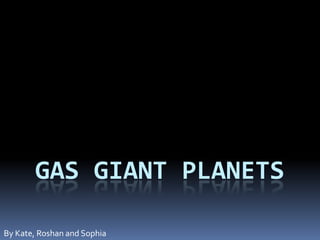
Gas giant planets
- 1. Gas Giant Planets By Kate, Roshan and Sophia
- 2. What are the Gas Giant Planets? The Gas Giant planets aka the Jovian Planets are a group of planets (Jupiter, Saturn, Uranus and Neptune) They have the lowest temperature in the solar system and the lowest density Photograph courtesy NASA/JPL/Space Science Institute
- 3. What are Gas Giant planets made of? Gas Giant Planets like Jupiter and Saturn are almost made of entirely gas. In the center of these planets Is what scientists call a rocky center, this is misleading because in the center they have liquid compounds and molten metals. Gas giant planets have a low density because they are comprised of mainly gas. Gas giant planets are made of various gases such as hydrogen and helium.
- 4. What is the inside of a gas Giant Planet look like? "Neptune." The World Book Student Discovery Encyclopedia. Chicago: World Book, Inc., 2005.
- 5. The Scale of Gas Giants Gas giants are the largest planets in our solar system They’re the lowest density planets Jupiter is the biggest planet in the solar system with it’s diameter is 11 times the diameter of earth.
- 6. Rotation and Axes Gas Giant Planets have a very quick rotation are the sun. They also have very quick day ranging from 10 hours to 17 hours. This has an effect on the planets shape because the faster the rotation the more flat the poles on the planes are. The Jovian planets also have a 7 degree tilt.
- 7. How where Jovian Planets formed? The Jovian planets, also known as the “Gas Giants” were formed like any other planets except they formed earlier. They’re many hypotheses that explain this matter. One of them is called the Nebular hypothesis. The Nebular hypothesis involves a nebulae, a giant cloud of gas & dust. The nebulae is pulled by gravity which causes it to collapse into a rolling disk that is flat. Then it merged into the sun and planets. Another hypothesis is a similar one to the Nebular hypothesis but it is called the Proto-planet hypothesis. The Proto-planet hypothesis includes a nebulae collapsing and the dust particles will stick together. The Jovian planets’ evolution was more evolved and it started earlier.
- 8. How where Jovian planets Discovered? The discovery of the Jovian planets were spaced out a lot through time. Jupiter, for example was discovered a really long time ago by the Romans. Also, another planet that was discovered a long time ago was Saturn. Saturn was visible in the night so the people who saw it were the people who discovered it. Uranus, also found a long time ago, was discovered by William Herschel in 1781. In 146, Johann Gelle discovered Neptune.
- 9. What are the atmospheres of Jovian Planets like? Each planet has distinct cloud layers Jupiter and Saturn have their atmosphere’s made up of Ammonia clouds (150° K), Ammonium Hydrosulfide clouds (200° K) and Water clouds (270° K) Uranus and Neptune have their clouds made up of Methane clouds (75 K)
- 10. What is the Density of the Jovian planets like?
- 11. What is a Jovian planet? A Jovian planet is a large planet not mainly composed of rock and other solid material. Jovian planets are made up of many gases, primarily hydrogen and helium. Jovian planets are much larger and farther from the sun than terrestrial planets. The four Jovian planets in our solar system are Jupiter, Uranus, Neptune, and Saturn. Jovian planets have a very low density and a large diameter.
- 15. Bibliography "The Jovian Planets." Nasa.gov. National Aeronautics and Space Administration, n.d. Web. 26 Jan 2011 Hamilton, Calvin. "The Solar System." The Solar System. Calvin J. Hamilton, n.d. Web. 26 Jan 2011. Wolf, Portia. "Wolf, Portia." The Outer planets. Pearson Education, Inc., 2007. Web. 31 Jan 2011.